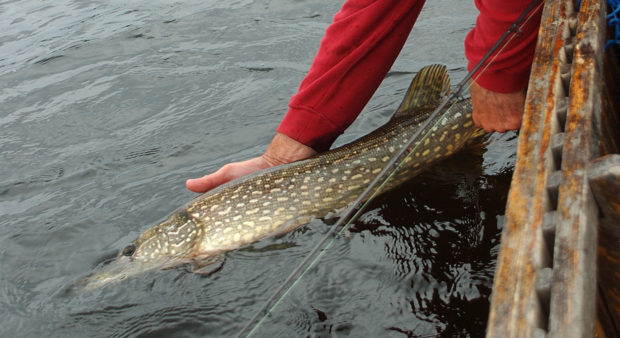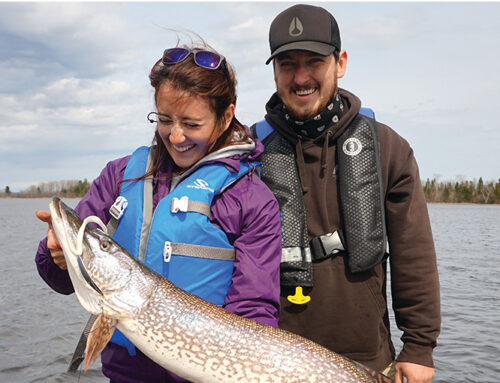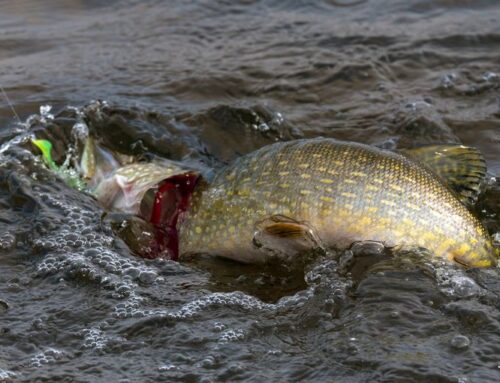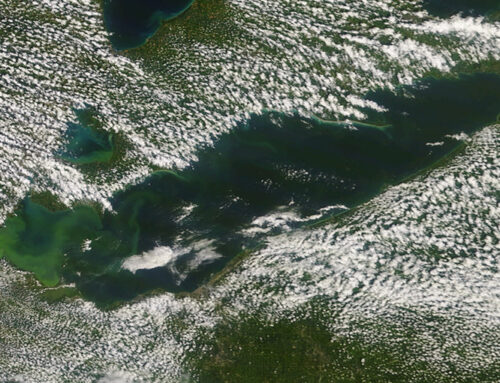Don’t believe everything you read or hear, or you might conclude that giant pike spend all spring in shallow bays, waiting for you to feed them the contents of your tackle box.
In reality, catching spring pike is often difficult. They’re not always in the shallows, and even when they are, they might be inactive. A number of factors must come together to produce storybook angling. For shallow spring pike, timing is everything.
Pike move shallow in spring to spawn immediately after ice-out. Often, their backs are out of the water when they spawn over shallow, submerged vegetation on floodplains of rivers, marshes, and bays of larger lakes. Pike then move slightly deeper to recover and wait for the water to warm. When it does, they begin feeding. This period provides the best fishing.
Later, when water heats up too much, they move out into deeper water. Pike are always reacting to water temperature. A number of clues indicate when the best fishing will occur.
Weather watcher
Pike will be in bays as soon as the ice breaks up, even though the main lake is often still frozen. Normally, pike will have spawned by the time you can move a boat around the lake, and they are either recovering from the spawn or moving out of bays.
Be on the water as soon as ice-out and the fishing season allow.
Pike are most active on warm, calm, sunny days, but this can be a double-edged sword. The water heats up and forces pike out of the shallows. Hope for cold days before you head out, then warm, sunny weather once you’re fishing. Finally, as soon as deep cabbage weed beds come up, pike move out of the shallows and into the greenery.
Hiding spots
Pike hold near cover when shallow. Rocks can provide cover, but hard bottoms don’t attract spring pike as well as soft bottoms do. Look for bays that have wood, vegetation, or a combination of the two.
The fish, however, avoid heavy cover that restricts their movement (bays with sporadic heavy cover are better then cover-choked bays). Pike will be on the edge of heavy cover with access to the open bay.
The biggest pike take the best locations, so be alert and ready if one area looks particularly good. Also, cast accurately to the side of cover, not right on it. Spring pike often spook if a lure lands too close, but they’ll swim quite a distance to hit a well presented bait.
Bottom composition changes point to pike locations. Rocks, mud, and sand transfer heat differently to the surrounding water. A mud bottom warms the water faster than does a sand bottom, and normally much faster than does a rocky bottom.
Bottom colour also has an effect on water temperature. Dark bottoms heat water more quickly than do lighter bottoms. There are times when pike hold in bays that seem to offer no cover. These bays usually have dark mud bottoms and are sunlit during the morning.
Time of day is another piece of the puzzle. Normally, the best times to fish shallow pike occur during late morning and again in the evening, when light levels are ideal for the fish. They can become inactive in early afternoon in bright light. Plan on fishing hard in the morning, taking a break, and fishing again as the sun starts to drop.
While guiding last season, pike educated me again on the importance of being there at the right time. As I drifted slowly into a bay I knew held pike, my guest got ready.
Timing
Soon I spotted several pike in the shallows. After I pointed out the fish to my companion, he placed the first cast well. The pike hardly moved. Twenty minutes went by without a hit before I lost patience.
We decided to drift right over the fish, just to have a look at them. Again, they seemed to see the boat as nothing more then a cloud going over. We left the bay and had lunch nearby, and then we decided to return and try again.
On the first drift we caught eight pike. One weighed more than 20 pounds! Within 45 minutes the pike went from sleeping logs to savage creatures from Jurassic Park.
Geography
Some bays warm faster than others. Pike can be in different stages of the spring cycle, depending on the characteristics of each bay. Try to find out which bays warm first, and fish them first, then work your way down the list to the coolest bay.
I’ve gone into a bay and the fish had already moved to deeper cabbage beds, while in the same lake, another bay still had tremendous shallow fishing. Bays that are exposed to the most sun(usually those on the north or northeast sides of a lake), have dark bottoms, are protected from the wind, and have feeder creeks or rivers will warm first.
What is the ideal scenario for shallow-water spring pike?
I’d look for the following conditions. Ice on the main lake has disappeared two days ago, due to a high wind and spring rain. Now the weather is calm and sunny, with temperatures in the low 70s°F (21°C). Water in your choosen bay is hovering in the high 50s°F (14°C)and is slightly discoloured. Pike are finished spawning and are ready to start feeding. Hope someone has a camera handy!







Leave A Comment